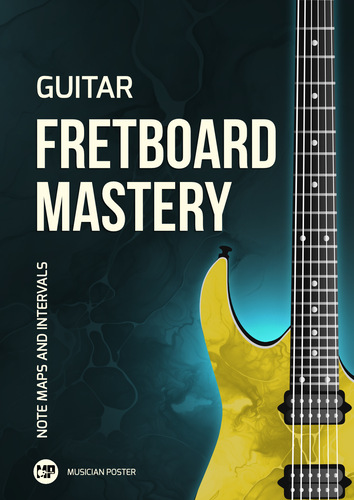Map of all intervals on the fretboard for an 8-string guitar in Standard F#-B-E-A-D-G-B-E tuning.
Intervals are given as scale degrees relative to the Major scale. These are the same scale degrees which are often used to write scale formulas and chords which is very handy as you don't need to make any conversion between the formulas and the diagram.
How You Can Use This Chart
Here's a list of scenarios where you may find map like this to be really helpful.
- Visualize and memorize intervals on the fretboard.
- Find different chord voicings, inversions or shapes.
- Understand scales in different positions across the fretboard.
- Explore new scales and modes.
- Find convenient patterns to play common arpeggios.
- Experiment with colorful modal arpeggios.
- Experiment with different instrument tunings.
But you are free and encouraged to come up with other uses as well and share them in the comment section below, I'd be happy to read your ideas. That way you are also sharing your experience with the rest of the community.
The Perks
- You don't necessarily need to know the location of notes on the fretboard to explore new scales, modes and experiment with chord voicings.
- It liberates you from the constraints of searching for a specific scale with a given root, such as G-Mixolydian. Instead, you only need to refer to the Mixolydian degrees formula, and the entire fretboard opens up for any desired "X"-Mixolydian root. The same principle applies to any type of chord – knowing its formula, you can construct it from any position on the fretboard.
- Instead of playing notes in isolation, you begin to focus more on the available intervals within the scale or chord, their colors, tensions, how they relate to each other, and what you can do with them to get the effect you're after.
Features and Benefits of the Chart
- Any scale and chord: This single diagram allows you to play any scale, any chord from any string and with any root note, provided that you have the degrees formula of the scale or chord in question.
- 12 and 24 frets: The charts are available in two variations: as 12 frets and as 24 frets.
- Color coding: Altered (b2, b3, etc.) and unaltered (1,2,3, etc.) scale degrees are color-coded differently to create clear visual separation between them.
- Movable vertically and horizontally: On the 24-fret version the degrees are arranged on the fretboard in a manner that allows you to choose any string and fret as a starting point. This arrangement provides you with ample flexibility to move both left and right from the root, spanning at least 6 frets on each string.
- Doubled frets: Fret numbers are provided both below and above the diagram, offering additional visual cues to pinpoint your location and navigate the fretboard with even greater ease.
Relationship Between Scale Degrees and Intervals
Alternative tuning spellings
For those who search for this content based on the tuning names, here are alternative spellings to increase the chances:
- F#BEADGBE
- F#-Standard
















0 Comments